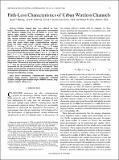Path-Loss Characteristics of Urban Wireless Channels
Author(s)
Herring, Keith T.; Holloway, Jack W.; Staelin, David H.; Bliss, Daniel W., Jr.
DownloadStaelin_Path-loss characteristics.pdf (1.457Mb)
PUBLISHER_POLICY
Publisher Policy
Article is made available in accordance with the publisher's policy and may be subject to US copyright law. Please refer to the publisher's site for terms of use.
Terms of use
Metadata
Show full item recordAbstract
Wireless channel data was collected in Cambridge, Massachusetts for diverse propagation environments over distances ranging from tens of meters to several kilometers using mobile 2.4-GHz transmitters and receivers. The 20-MHz bandwidth signals from eight individually movable van-top antennas were Nyquist sampled simultaneously with 12-bit accuracy. Although path-loss variance for any given link length within single residential/urban neighborhoods was large, single streets typically exhibited path-loss, L(dB)=-10 log10 (Pr/Pt) ?? 10?? log10 r + C, where P is the received or transmitted power, r the link-length, ?? the street-dependent path-loss coefficient, and C the loss incurred at street intersections. Measurements yielded ?? ?? 1.5 + 3.2?? ?? 0.27 for 2 < ?? < 5; ?? is the fraction of the street length having a building gap on either side. Experiments over links as short as 100 meters indicate a 10-dB advantage in estimating path loss for this model compared to optimal linear estimators based on link length alone. Measured air-to-ground links were well modeled by ?? = 2 for the elevated LOS path, and by stochastic log-normal attenuation for the ground-level scattering environment. These models permit path-loss predictions based on readily accessible environmental parameters, and lead to efficient nodal placement strategies for full urban coverage.
Date issued
2009-11Department
Lincoln Laboratory; Massachusetts Institute of Technology. Research Laboratory of ElectronicsJournal
IEEE Transactions on Antennas and Propagation
Publisher
Institute of Electrical and Electronics Engineers (IEEE)
Citation
Herring, K.T. et al. “Path-Loss Characteristics of Urban Wireless Channels.” IEEE Transactions on Antennas and Propagation 58.1 (2010): 171–177. © Copyright 2009 IEEE
Version: Final published version
ISSN
0018-926X
1558-2221